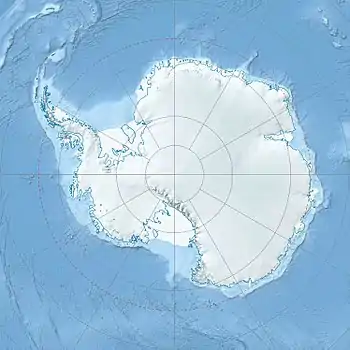Axel Heiberg Glacier
The Axel Heiberg Glacier in Antarctica is a valley glacier, 30 nmi (35 mi) long, descending from the high elevations of the Antarctic Plateau into the Ross Ice Shelf (nearly at sea level) between the Herbert Range and Mount Don Pedro Christophersen in the Queen Maud Mountains.
| Axel Heiberg Glacier | |
|---|---|
 Aerial view of the Axel Heiberg Glacier in 1956–57 | |
 Location of Axel Heiberg Glacier in Antarctica | |
| Type | Valley glacier |
| Location | Queen Maud Mountains, Antarctica |
| Coordinates | 85°25′S 163°0′W |
| Length | 56 km (35 mi) |
| Thickness | unknown |
| Terminus | Ross Ice Shelf |
| Status | unknown |
This huge glacier was discovered in November 1911 by the Norwegian polar explorer Roald Amundsen, and named by him for Axel Heiberg, a Norwegian businessman and patron of science who contributed to numerous Norwegian polar expeditions. Amundsen used this glacier as his route up onto the polar plateau during his successful expedition to the South Pole.[1]
Unlike the big “outlet” glaciers such as the Beardmore, Shackleton and Liv, the Axel Heiberg is in effect an alpine glacier, cut off from the Plateau by a dolerite rim and fed entirely from the uncharacteristically heavy snow falling within its own catchment. It falls over 2,700 m (9,000 ft) in 32 km (20 mi), most of it over 11 km (7 mi).[2]
References
- "Axel Heiberg Glacier". Geographic Names Information System. United States Geological Survey, United States Department of the Interior. Retrieved 9 January 2014.
- Otway, Peter (21 September 2011). "Gateways to the Pole: Mapping Amundsen's and Scott's Routes through the Transantarctic Mountains Fifty Years Later" (PDF). www.antarctican.org. Archived from the original (PDF) on 12 November 2011. Retrieved 9 January 2014.
![]() This article incorporates public domain material from "Axel Heiberg Glacier". Geographic Names Information System. United States Geological Survey.
This article incorporates public domain material from "Axel Heiberg Glacier". Geographic Names Information System. United States Geological Survey.
| Types | |||||||
|---|---|---|---|---|---|---|---|
| Anatomy | |||||||
| Processes | |||||||
| Measurements | |||||||
| Volcanic relations | |||||||
| Landforms |
| ||||||
| |||||||